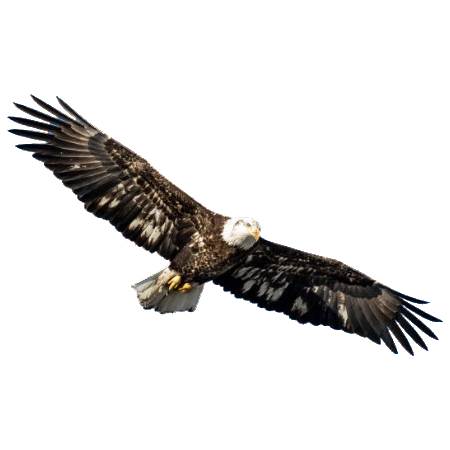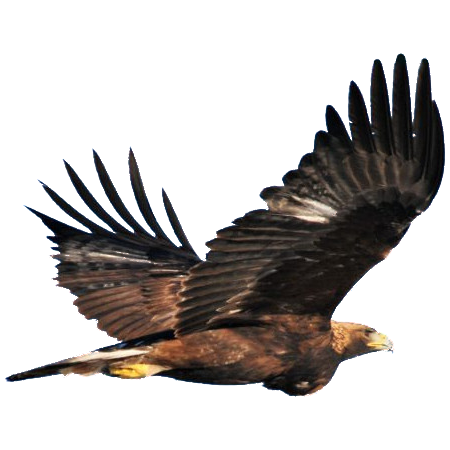Fascinating Eagle FAQ
Learn about Bald and Golden Eagles—
and how they compare to one another
Click the category you want to explore below, and feel your knowledge soar.
Get to know Bald Eagles
What do Bald Eagles look like?
Adult Bald Eagles have dark brown feathers on their body and wings, and white feathers on their head and tail. The adult’s beak and feet are yellow.
Juvenile Bald Eagles do not have white heads. In fact, in their first year of life, they are dark brown over their body wings, head, and tail. Their beak and eyes are dark. As they age, juveniles may show white feathers anywhere on the body, especially the breast and under the wings.
At three to four years of age, they begin to develop the white head and tail of the adult. Their beak and eyes lighten in color as they reach adulthood.
A complete white head and tail usually develop between ages four and six.
Is a Bald Eagle really bald?
No. Bald Eagles have about 2,000 feathers that cover their heads. Their name comes from the old English word “balde”, which originally meant white.
How long do Bald Eagles live?
In the wild, both Bald and Golden Eagles can live 20-25 years in the wild. In human care, both can live more than 40 years due to a controlled environment, nutrient-rich diet, and veterinary care.
Unfortunately, 70-80% of eagles die before they reach adulthood at five years of age.
How fast can Bald Eagles fly?
Bald Eagles can soar 30 mph using powerful wing-beats and can fly even faster when diving for prey (stoop). Bald Eagles can dive up to 100 mph, while Golden Eagles can reach 150 mph.
How far can Bald Eagles see?
Both Bald and Golden Eagles have incredible eyesight, which is why the term “eagle eye” refers to someone who sees exceptionally well. While we humans have 200,000 cones in our eyes to help us see in color, Bald and Golden Eagles have close to one million cones.
They also have two focal points that allow them to see in front of them, and at a 45-degree angle on either side of them…at the same time! As far as distance goes, both eagles can see an animal the size of a rabbit running from three miles away.
What do Bald Eagles eat?
About 70% of a Bald Eagle’s diet is made up of fish. However, Bald Eagles are also scavengers and therefore eat dead animals they find.
Interestingly, Bald Eagles have featherless legs and strong talons that are designed for catching fish in the water, while Golden Eagles have feathered legs and strong talons designed to catch bigger prey like jackrabbits, wild turkeys, squirrels, and rodents on land.
What is the length of a Bald Eagle’s wingspan?
The average wingspan of a Bald Eagle ranges from six to seven and a half feet (182cm-229cm). Their wingspan, however, depends on their overall size and can therefore vary.
Are Bald Eagles endangered?
While Bald Eagles were removed from the Federal Endangered Species list on June 28, 2007, there continue to be threats to Bald Eagles that are often human-made.
These threats include lead poisoning, which is often a result of gut piles left behind by hunters, vehicles that eagles eating carcasses on the side of the road view as predators, and powerlines.
Do male and female Bald Eagles look different?
No, male and female eagles have the same coloration.
How much does a Bald Eagle weigh?
The average weight of a female Bald Eagle is 10-14 pounds, however, this can vary depending on where an eagle is from. Generally, males weigh about 25% less than females from the same area.
Southern Bald Eagles tend to be smaller than those in the northern parts of their range. For example in Alaska, females might weigh up to 18 pounds, whereas eagles in Florida can weigh as little as six to eight pounds.
What is the scientific name for a Bald Eagle?
The scientific name of a Bald Eagle is Haliaeetus leucocephalus.
Haliaeetus means “member of the sea” or “fish eagle group.”
Leucocephalus means white head (leuco=white, cephalus = head).
How can Bald Eagles stand on the ice without their feet freezing?
Bald Eagles and other cold-weather birds have special circulation in their feet and legs that allow them to withstand very cold temperatures.
Their legs and feet also have little soft tissue, so they don’t require as much warm blood flow. When they need a quick warm-up, they can tuck one foot up against their body, underneath all those warm, down feathers. This makes for a great way to warm up the toes.
Can eagles swim?
Bald Eagles do not dive into the water but rather skim across the top catching fish near the surface. During salmon runs in Alaska, Bald Eagles have been observed standing on the shoreline and pouncing on salmon as the fish swims into shallow water.
If a Bald Eagle catches a fish that is too heavy to lift, it may grasp the fish with its talons and use its wings like oars to swim to shore.
Do Bald Eagle pairs migrate together?
There is data to suggest that pairs may not migrate together. Rather, each eagle will return to the nest and territory that they have used successfully in previous years. Generally, juveniles migrate prior to the adults departing.
How big is a Bald Eagle’s nest?
The average size is four to five feet in diameter and two to four feet deep. Eagles’ nests grow each year as they often return to the same nest with about one foot of material to add.
The largest known Bald Eagle nest was nine feet across and 21 feet deep.
Why were Bald Eagles endangered?
In the 1950s, a chemical known as DDT (dichlorodiphenyltrichloroethane) was introduced as a widespread insecticide to prevent the spread of malaria.
DDT was often used in waterways and consumed by insects, which made their way up the food chain to eagles. The amount of DDT consumed by eagles was enough to interfere with the processing of calcium and resulted in deformed and thin eggshells.
Female Bald Eagles would lay eggs, and crush them with their body weight. Because bald eagles breed only once per year and have a low reproductive rate, the Bald Eagle population declined steeply throughout the 1960s and 1970s.
What are the leading causes of eagle mortality?
Only 50 percent of eaglets reach one year of age. Some die from falls, starvation, or siblicide.
Once fledged, many eagles die from impact injuries, starvation, disease, shooting, poisoning, and electrocution.
Lead poisoning is a common cause of injury and is most often fatal. Bald Eagles can get lead poisoning from gut piles left behind by hunters, who assume other animals appreciate the leftovers. However, the smallest fragments of lead bullets in the gut pile are enough to cause severe neurological issues or kill an eagle within days.
The Raptor Center of the University of Minnesota has found that about 25-28% of eagles admitted for rehabilitation in the last forty years have had lead in their system.
Get to know Golden Eagles
What do Golden Eagles look like?
Golden Eagles have dark brown feathers over their entire body, with golden feathers on the nape, or back of the neck. The beak is tri-colored; black at the tip, grayish-blue in the mid-section, and yellow at the base. Their legs are feathered to the toes because they hunt on land and not water, like the Bald Eagle.
How long do Golden Eagles live?
Similar to Bald Eagles, Golden Eagles can live approximately 20-25 years in the wild, so long as they survive to adulthood. In human care, both Bald and Golden Eagles are known to live more than 40 years due to a controlled environment, nutrient-rich diet, and veterinary care.
Where are Golden Eagles most commonly found?
Golden Eagles are found throughout the northern hemisphere in Europe, Asia, North Africa, and North America.
Golden Eagles in North America are primarily found in the western states and from Mexico through Alaska. There are also small breeding populations in northern Ontario and Quebec, with a wintering population in the eastern United States.
Golden Eagles are regular winter inhabitants in the midwestern United States; in the Blufflands of southeast Minnesota, western Wisconsin, and northeast Iowa known as the driftless region.
What protections are Golden Eagles given?
Golden and Bald Eagles are both protected under the Bald and Golden Eagle Protection Act, passed by Congress in 1940.
The Act prohibits the taking possession of any Bald or Golden eagle, alive or dead, including any part, nest, or egg, unless allowed by permit.
How much does a Golden Eagle weigh?
Female Golden and Bald eagles both weigh between 10 and 14 pounds, while males weigh approximately 25% less than females from the same area.
How many eggs does a Golden Eagle lay?
Like the Bald Eagle, the average clutch of a Golden Eagle is one to three eggs. The eggs are laid in three to four-day intervals and hatch in the order they are laid.
What color and size are Golden Eagle eggs?
Golden Eagle eggs are off-white with irregular brownish spotting and average three inches long by two inches wide. The average weight is five ounces,
How do Golden Eagles choose a nest location?
Golden Eagles prefer open or semi-open undeveloped habitats. When nesting on cliffs, the selection of the site may be based on an exposure that protects the nest and eaglets from harsh weather conditions.
Where do Golden Eagles build their nests?
Golden Eagles usually nest on cliffs or in trees in open or semi-open habitats. They avoid heavily forested and developed areas but have been observed nesting on human-made structures such as observation towers or windmills.
How big is a Golden Eagle nest?
Golden Eagles’ nests are similar in size to Bald Eagles’, with the average diameter being 5-6 feet and the depth being 2-4 feet.
What is a Golden Eagle’s wingspan?
The average wingspan of a Golden Eagle is similar to a Bald Eagle and ranges from about six to seven and a half feet (182cm-229cm).
What is the scientific name for a Golden Eagle?
The scientific name for the Golden Eagle is Aquila chrysaetos.
Aquila means eagle in Latin. Chrysaetos means golden in Greek.
What color are Golden Eagles’ eyes?
Adult Golden Eagles have brown or hazel eyes, occasionally with some flecks of gold and brown. Juvenile Golden Eagles have dark brown eyes.
When do Golden Eagles attain full size?
Golden Eagles attain full skeletal size in 8-10 weeks, although their muscle mass and flight feathers reach full growth post-fledging.
What do Golden Eagles eat?
Golden Eagles are terrestrial predators that feed on mammals, birds, and reptiles. They are known to take prey as large as pronghorn or white-tailed deer. Common prey items for Golden Eagles in the Midwest are squirrels, rabbits, and wild turkeys.


